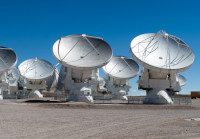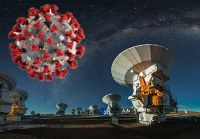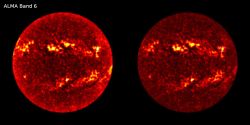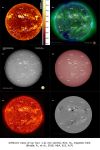The first several papers related to the MSOC project were published recently. A paper by Selhorst et al. "Solar Polar Brightening and Radius at 100 and 230 GHz Observed by ALMA" studies polar brightenings of the Sun at radio frequencies using ALMA observations and comparing them to several theoretical models. A paper by Skokić and Brajša "ALMA Solar Ephemeris Generator" published in the Mining-geological-petroleum engineering bulletin describes an online software tool developed by the authors for easy preparation of solar observations with ALMA.
Vršnak studied the physical background of the evolution of a coronal magnetic flux rope embedded in the magnetic arcade during the gradual-rise pre-eruptive stage in a paper "Gradual Pre-eruptive Phase of Solar Coronal Eruptions" published in Frontiers in Astronomy and Space Sciences.
Two MSOC papers were published in the same issue of Astrophysical Journal. Vršnak et al. in "Heliospheric Evolution of Magnetic Clouds" present analysis of interplanetary evolution of 11 magnetic clouds. The analysis reveals that in a statistical sense, the expansion of the studied magnetic coluds (MCs) is compatible with self-similar behavior. However, individual events expose a large scatter of expansion rates, ranging from very weak to very strong expansion. Also, a discrepancy between the magnetic field decrease and the increase of the MC size was found, indicating that magnetic reconnection and geometrical deformations play a significant role in the MC evolution. In the paper "Turbulent Diffusion Derived from the Motions of SDO/AIA Coronal Bright Points" Skokić et al. study the motions of coronal bright points to infer the character and intensity of the solar diffusion processes. Results indicate subdiffusion on meso- to supergranular scales.
 After almost a full year of suspended operations due to the global COVID-19 pandemic, Atacama Large Millimeter/submillimeter Array (ALMA) has restarted science observations in March 2021. Also, the call for Cycle 8 proposals has been re-opened with a deadline set on April 21, 2021. Our group submitted one solar related proposal. This call features a new scheme for reviewing and grading proposals where PIs of the proposals are required to review other proposals in a double-blind fashion instead of a review panel, as was the case in the past.
After almost a full year of suspended operations due to the global COVID-19 pandemic, Atacama Large Millimeter/submillimeter Array (ALMA) has restarted science observations in March 2021. Also, the call for Cycle 8 proposals has been re-opened with a deadline set on April 21, 2021. Our group submitted one solar related proposal. This call features a new scheme for reviewing and grading proposals where PIs of the proposals are required to review other proposals in a double-blind fashion instead of a review panel, as was the case in the past.






